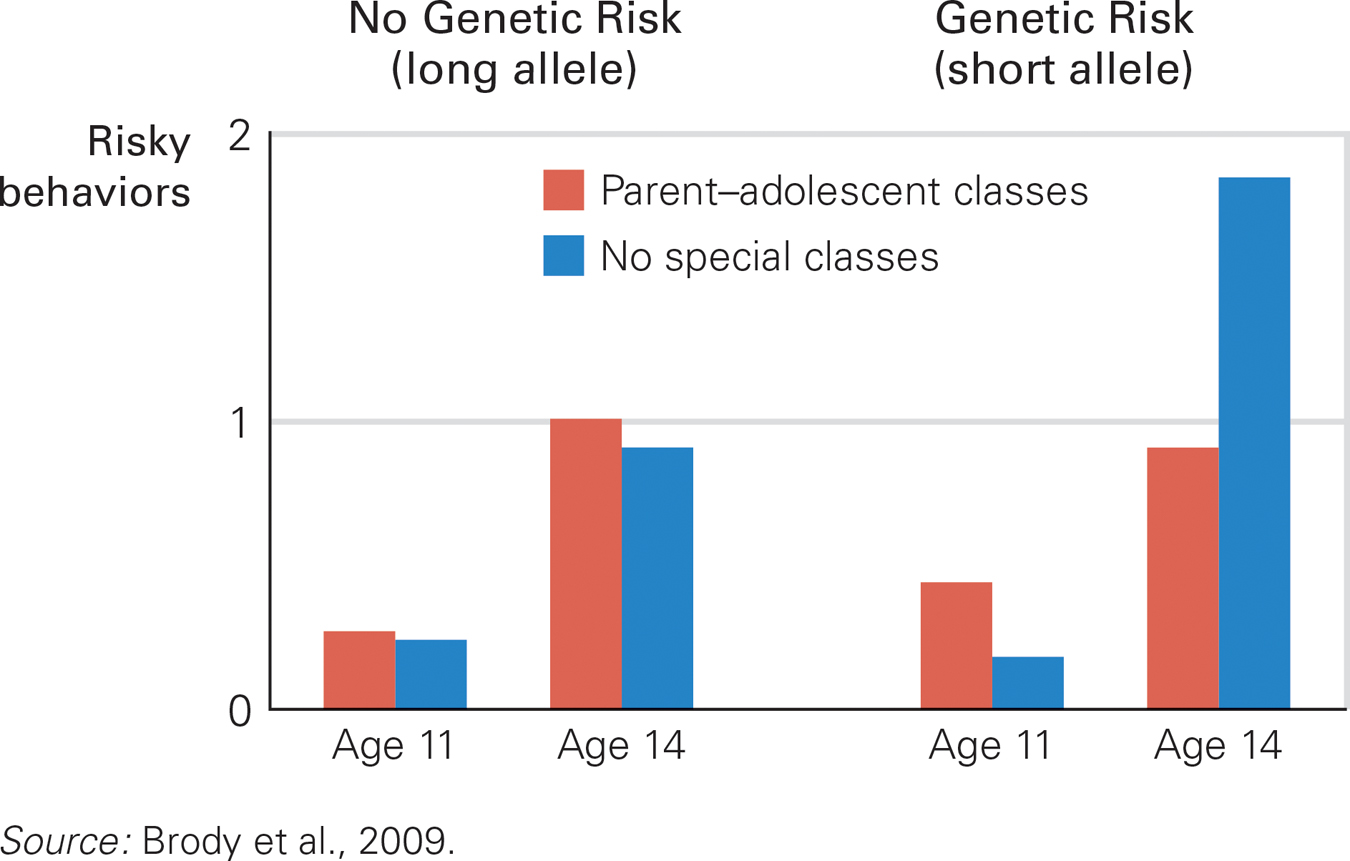Relationships with Adults
Adolescence is often characterized as a period of waning adult influence, when children distance themselves from their elders. This picture is only half true. Adult influence is less immediate but no less important.
Parents
The fact that parent–
Normally, conflict peaks in early adolescence, especially between mothers and daughters. The most common conflict is not fighting but instead bickering—repeated, petty arguments (more nagging than fighting) about routine, day-
Each generation tends to misjudge the other, and that adds to the conflict. Parents think their offspring resent them more than they actually do, and adolescents imagine their parents want to dominate them more than they actually do (Sillars et al., 2010).
515

Unspoken concerns need to be aired so both generations better understand each other. Imagine a parent seeing filthy socks on the living room floor. The parent might interpret that as a deliberate mark of disrespect and react angrily, yelling “Pick up those socks right now.” But perhaps the adolescent was merely distracted, oblivious to the parent’s desire for a neat house. If so, then the parent could merely sigh and put the socks in the hamper, or in the child’s bedroom.
Some bickering may indicate a healthy family, since close relationships almost always include conflict. A study of mothers and their adolescents suggested that “although too much anger may be harmful …, some expression of anger may be adaptive” (Hofer et al., 2013). In this study, as well as generally, the parent–
Over the years, teenagers learn to regulate their moods and parents to grant autonomy. By age 18, many teenagers appreciate their parents (and put socks in the hamper), and many parents adjust to their child’s independence (suggesting socks belong in the child’s room) (Masche, 2010).
You already know that authoritative parenting is usually best for children and that uninvolved parenting is worst. (Developmental Link: Parenting styles are discussed in Chapter 10.) This continues in adolescence. Although teenagers may claim that their parents are irrelevant, that is not true. Neglect is always destructive and authoritarian parenting can backfire, resulting in children who lie or leave.
a view from science
Parents, Genes, and Risks
Research on human development has many practical applications. This was evident in a longitudinal study of African American families in rural Georgia that involved 611 parents and their 11-
Half of them were assigned to the comparison group, with no special intervention. The other half were invited to seven two-
The parents learned the following:
The importance of being nurturing and involved
The importance of conveying pride in being African American (called racial socialization)
How monitoring and control benefit adolescents
Why clear norms and expectations reduce substance use
Strategies for communication about sex
The 11-
The importance of having household rules
Adaptive behaviors when encountering racism
The need for making plans for the future
The differences between them and peers who use alcohol
After that first hour, the parents and 11-
Then, four years after the study began, the researchers read new research that found heightened risks of depression, delinquency, and other problems for people with the short allele of the 5-

Not Yet The risk score was simply one point for each of the following: had drunk alcohol, had smoked marijuana, had had sex. As shown, most of the 11-
516
The fact that 14 hours or fewer of training (some families skipped sessions) had an impact on genetically sensitive boys is amazing, given all the other influences surrounding these boys over the years. Apparently, since the parent–
Genetic sensitivity was crucial. In a follow up study when the boys were 19, those boys with the short 5-
Cultural Differences
Expectations vary by culture, as do justifications (Brown & Bakken, 2011). For example, in Chile, adolescents usually obey their parents, but if they do something their parents might not like, they keep it secret (Darling et al., 2008). By contrast, many U.S. adolescents deliberately provoke an argument by boldly proclaiming what should be allowed, even if it is something they themselves never do (Cumsille et al., 2010).
Several researchers have compared parent–
Closeness Within the Family
More important than family conflict or individual autonomy may be family closeness, which has four aspects:
Communication (Do family members talk openly with one another?)
Support (Do they rely on one another?)
Connectedness (How emotionally close are they?)
Control (Do parents encourage or limit adolescent autonomy?)
517

No social scientist doubts that the first two, communication and support, are helpful, perhaps essential, for healthy development. Patterns set in place during childhood continue, ideally buffering some of the turbulence of adolescence (Cleveland et al., 2005; Laursen & Collins, 2009). Regarding the next two, connectedness and control, consequences vary and observers differ in what they see. How do you react to this example, written by one of my students?
I got pregnant when I was sixteen years old, and if it weren’t for the support of my parents, I would probably not have my son. And if they hadn’t taken care of him, I wouldn’t have been able to finish high school or attend college. My parents also helped me overcome the shame that I felt when … my aunts, uncles, and especially my grandparents found out that I was pregnant.
[I., personal communication]
My student is grateful to her parents, but did teenage motherhood give her parents too much control, requiring her to depend on them instead of seeking her identity? Indeed, had they unconsciously encouraged pregnancy by permitting her to be with a boy but not explaining contraception?
An added complexity is that this young woman’s parents had emigrated from South America. Cultural expectations affect everyone’s responses, so her dependence may have been normative in her culture but not elsewhere. A longitudinal study of nonimmigrant adolescent mothers in the United States found that most (not all) fared best if their parents were supportive but did not take over child care (Borkowski et al., 2007). Whether this is true in other nations has not been reported.
A related issue is parental monitoring—that is, parental knowledge about each child’s whereabouts, activities, and companions. Many studies have shown that, when parental knowledge is the result of a warm, supportive relationship, adolescents are likely to become confident, well-


Video: Parenting in Adolescence examines how family structure and communication styles and can help or hinder parent–
Adolescents play an active role in their own monitoring: Some happily tell parents about their activities, whereas others are secretive (Vieno et al., 2009). A “dynamic interplay between parents and children” (Abar et al., 2014. p. 2177) is particularly apparent in adolescence. Most teenagers disclose only part of the truth to their parents, selectively omitting whatever their parents would not approve (Brown & Bakken, 2011).
Thus, monitoring may signify a mutual, close interaction (Kerr et al., 2010). However, monitoring may be harmful when it derives from suspicion. Especially in early adolescence, if adolescents resist telling their parents much of anything, they are more likely to develop problems such as aggression against peers, law-
518
Control is another aspect of parenting that can backfire. Adolescents expect parents to exert some control, especially over moral issues. However, overly restrictive and controlling parenting correlates with many adolescent problems, including severe depression (Brown & Bakken, 2011). Further, parents sometimes restrict the wrong activity. One researcher laments that parents sometimes refuse to let their children use social media, inadvertently limiting their ability to sustain supportive friendships (boyd, 2014).
Other Adults
Parents are important but so are many other adults. One of the admirable characteristics of most adolescents is that they know many people, sometimes seeking advice and help from neighbors, teachers, relatives, and so on. This is characteristic of resilient teenagers, who find the support they need (Masten, 2014).
The impact is notable when adults take time to listen. For many youths, the most patient advisors are family members—
Adults with no biological relationship to the young person can also be significant (Chang et al., 2010; Scales et al., 2006). For instance, regarding the four arenas of identity development (religion, politics, vocation, sex), clergy affect a young person’s faith, political leaders mold values, school counselors influence vocational aspirations, and adults in satisfying partnerships are role models (Lerner & Steinberg, 2009). In addition, many adolescents admire celebrities—
SUMMING UP Relationships with adults are essential during adolescence. Parents and adolescents often bicker over small things, especially common with mothers and daughters in early puberty, but squabbling between parents and teenagers does not mean that the relationship is destructive. In fact, parental guidance and ongoing communication promote adolescents’ psychosocial health. Among the signs of a healthy parent–
WHAT HAVE YOU LEARNED?
Question 16.8
3Kilp8OTY1bFKoImVXSIH/A4I2mUeZWPqwb2pLgeSFvHley6IxMT+McvZBKbgcGyAdolescents are establishing their independence and asserting their autonomy while parents still want to maintain some control over their adolescents' lives. Each generation misjudges the other: Parents think their offspring resent them more than they actually do, and adolescents imagine their parents want to dominate them more than they actually do. Unspoken concerns need to be aired so both generations better understand each other. Some bickering may indicate a healthy family, since close relationships almost always include conflict.Question 16.9
Fesw+3AU5FtSEjfgrjXqEq+KDuROYep8PkwE+p7JlDSR/xsnd3s7KtwGkTgNAtiSvxW0uz43oQK1AzUEc2SWCeBLRjeSf8bTMCiIYy4zLjTOH57nIXEo1ZJX3OTLRAyFp3L+AazDVPErhPYeOw+Jzw==Conflict between parents and children normally peaks in early adolescence. Over the years, teenagers learn to regulate their moods and parents to grant autonomy. By age 18, many teenagers appreciate their parents, and many parents adjust to their child's independence.Question 16.10
PkVJOLWXNzBLGl35G/j7jaQkZajz+MZPTOPrS++HMKMLQ90adenf5oFVF6t6HIBYddLpD3pYsYZ6Y9PkBLY5ISxtkjKZ0buz7aSL5A4glxBNXIJf2iS2Lk34ipDaOcnfqrCVVXFsFu70JAeMo5hS6SB60TYXTl7eQUFPyBV/8AHA28dbWhen parental monitoring grows out of a warm, supportive relationship, children are likely to become confident, well–educated adults who avoid drugs and risky sex. However, parental monitoring may be harmful when it derives from suspicion instead of from a warm connection. Question 16.11
kUwnFADRHO7aHFzim8k9do4iL4p1M0VmO4Lk1UI1WVmsXLAeKNQlFwE+/QWm4eE9CKnDYgSKy6G5wvOFw1Y+8SwDCuTPUhZdbKpJJxhHjrWMWOZTBEs0t6lQdEtaIYdLcAGQIaOpS45jLBwcrixNscICoP8=Excessive closeness and control can backfire on parents—leading to adolescent rebellion. Question 16.12
WQV8NhYMRPEd2NEu1OmkxaDp3GqfnNbhXT/uYQ4dL8NrVoDZhIIKpdoSqN05ibLZVl6QnmIzAf86xz7Wo/xzi0D03zw=Adults such as clergy, school counselors, and political leaders may heavily influence religion, vocation, and political choice. Non–parent family members are able to discuss “taboo” topics with a teen. Links between teenagers and relatives are especially common in developing nations and immigrant groups.
519